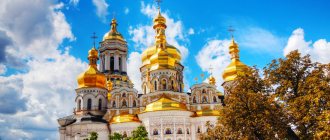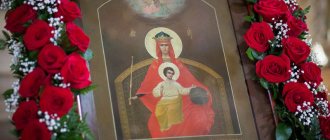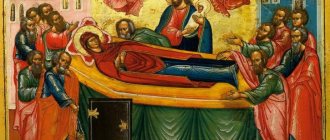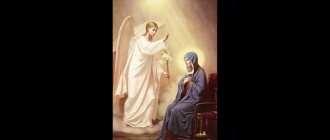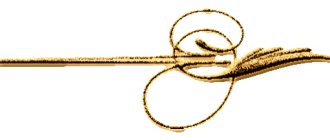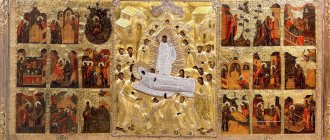The Svenskaya Pechersk Icon of the Mother of God is known for its miracles that happened to believers who prayed to it. She is amazing with her beauty and the incredible legends surrounding her.
However, all believers know that everything is possible with God, therefore they come to the Holy Virgin Mary with prayers for her intercession and intercession for them, sinners, before the Holy Lord. Stories about the miracles of the holy face of the “Pecherskaya” confirm that the Virgin Mary always answers sincere prayers.
History of the holy image
The Svenskaya Pechersk Icon of the Mother of God was painted by the Monk Alypius. He was a famous master of icon painting and studied this skill from the masters of Byzantium, who arrived in Kyiv at the invitation of the prince to paint the Assumption Cathedral of the Kiev Pechersk Lavra. Monk Alypiy belonged to this monastery and after training he became an icon painter, the first in Rus'. The years of his life are unknown; only information about the date of his death - 1114 - has survived to this day.
More about Orthodox laurels:
- Holy Dormition Pochaev Lavra
- Holy Trinity Lavra of Sergius
- Holy Trinity Alexander Nevsky Lavra
For reference!
It is unknown when exactly the plaque of Our Lady of Svens was created, but thanks to legends, believers of the 21st century can learn about the miracles that were performed by him. One of the most famous miracles is the healing of Prince Chernigov from blindness. The legend of the monks tells about this. In the summer of 1288, the ruler of Chernigov, who was visiting Bryansk, became blind. This was according to the will of the Lord, who created this disease to demonstrate His strength and power.
Already at that time, the board was known for its miracles, having heard about which, the ruler sent a messenger and his priests to the Lavra and its monastery, and asked the abbot to send the miraculous one to Bryansk so that he could pray and venerate it for healing.
After consulting with all the monks, the archimandrite of the Pechersk Lavra allowed the envoys to take the miraculous image.
They decided to deliver the board along the Desna River, but during the voyage the boat suddenly stopped, the sailors decided that this was a sign of rest and, having moored, spent the night. The next morning, no one could find the image of the Mother of God, and only after some time it was discovered among the branches of a spreading oak tree in the grove.
All this happened near the Svenya River, on a hill. The blind sovereign learned about this miracle and went on foot to the grove to pray. Arriving, he prayed with tears for healing and promised to build a temple and monastery in that place. Immediately after the prayer, the prince’s sight returned. Having removed the face from the tree, the bishop who was with the prince served a thanksgiving prayer service in front of him. After that, all the people began to cut down the trees in that place, and all the wood was used for painting icons.
There, after some time, a temple with a monastery was erected, and it was called “The Dormition of the Blessed Virgin Mary.”
The board was kept in the monastery built on that place and left it only for restoration in Moscow, where it was placed in a frame consisting of gold, silver and decorated with an abundance of precious stones.
Important! Since then, it has been known as miraculous, because it is capable of restoring sight to the blind, freeing them from demons and performing other miracles.
Returning to the Pechersk Lavra, the face never left the caves in which it was kept. And the monks began to write lists from it.
Icon “Our Lady of Pechersk (Svenskaya)”, last third of the 18th century
Troparion and Kontakion to the Most Holy Theotokos before the Icon of Her “Pechersk”
Troparion, tone 4
Today the Pechersk house triumphs brightly / and rejoices at the appearance of the image of the Mother of God / with the soulless faces of the Pechersk fathers, / with whom we cry incessantly // Rejoice, O Gracious One, praising the peace of Pechersk.
Translation: Today the Pechersk monastery shines, and countless Pechersk fathers rejoice at the appearance of the image of the Mother of God, and together with them we also constantly cry: “Rejoice, Blessed One, reverence of the Pechersk.”
Meaning of the icon
The amazingly beautiful Svensky image measures 67x42 cm.
Despite its small size, it contains:
- the seated Holy Virgin Mary;
- Child Christ;
- Theodosius of Pechersk;
- Anthony of Pechersk.
Due to its age, the painting is quite worn and there are many inscriptions of later dates on it, however, despite this, the characters depicted can still be clearly seen. The Most Pure Virgin sits on the throne so that her right leg rests on a small stone, and her left leg rests on the pulpit. The throne itself is golden, and its base is made in the form of arches. The Child Christ is on the left hand of the Mother of God and blesses people with his fingers.
The founders of Russian monasticism, Theodosius and Anthony, stand on the right and left hands of the Mother of God, respectively, and hold scrolls. Theodosius is depicted with his head uncovered and in a robe, but Anthony is dressed in schematic vestments.
Theodosius and Anthony are the founders of monasticism in Rus', who created the eastern branch of Christian monasticism. Theodosius was canonized third in Rus', immediately after the innocently murdered princes Boris and Gleb. They hold scrolls, on each of which is written a prayer to the Holy Virgin and a petition for pardon for Rus'.
Read about other Orthodox saints:
- Saint Mitrophan of Voronezh
- Venerable Paisiy Svyatogorets
- Holy Great Martyr John the New, Sochaevsky
The Virgin Mary depicted on the throne symbolizes her power as the Queen of Heaven. This is how the Virgin Mary was often depicted, trying to show her strength and power on earth. This image is repeated in almost every icon painted in Byzantium.
Miracles revealed through the icon of the Mother of God of Svenskaya
From its very appearance, the Svensk Icon of the Mother of God was considered miraculous. The most famous miracles revealed through her are the following:
- Rescue of monks from a collapsed temple. It happened in 1566, when the vaults of a newly built church collapsed on the heads of the brethren in the Svensk monastery. All the monks, led by Abbot Martinian, remained unharmed and safely carried the Mother of God image out from under the rubble.
- Cure of the possessed Potapius and Athanasius. Both cases occurred in 1673. After his recovery, Potapius became a monk and remained to live in the Svensk monastery. A few years later, in 1685, another case of recovery from demonic possession was recorded - in the peasant John from Trubchevsk.
- Curing the blindness of the daughter of the Bryansk merchant Klimov. Happened in 1830. The girl became blind after a long eye infection and was cured during a prayer service in front of the Svensk Icon.
In Bryansk, the icon of the Svenskaya Mother of God is considered the protector of the city. The miracle of liberation of the Bryansk region from the French is still remembered here:
“In 1812, Napoleonic troops were supposed to capture the city of Bryansk due to its special strategic position. The fact that deliverance occurred is simply amazing, because there were no barriers. If Moscow had already been taken, then Bryansk did not present any obstacle to Napoleonic troops. But what do the residents do? They trust only in God’s help - with repentance, with a sincere desire to change everything. They came to the Svensky Monastery, took our shrine, and in a religious procession began to go around the city and surrounding villages with it. And during the way of the cross, which went on for more than one day, they learned that Napoleon had turned in the other direction.”
Hegumen Alexy (Tyurin), abbot of the Svensky Assumption Monastery
It is interesting that Napoleon’s troops more than once headed towards the Bryansk region, but each time they turned away for some reason. So during the entire Patriotic War of 1812, not a single French soldier entered Bryansk.
How does an image help?
The Svenskaya Mother of God is known for many miracles that accompany her throughout her existence. The monks documented many of them, and today you can read about those miracles in their chronicles. All the sacraments from wedding to baptism were performed before her, and she was always revered, regardless of her location, be it Kyiv or Bryansk.
You should pray to the Lord in front of the icon of Our Lady of Svensk about:
- healing the sick;
- return of vision;
- liberation from demons;
- restoring mental health and balance.
Believers ask before the face for strengthening of faith and perseverance in trials, and non-believers pray to her for pardon of their souls and intercession before the Lord.
Important! Often prayers of thanksgiving are offered before the face for the salvation of the souls of relatives and friends, for the healing and mercy of the Lord.
Our Lady of Pechersk, 19th century
Location of the original Svensk Icon of the Mother of God
Currently, the original of the Bryansk shrine is in the State Tretyakov Gallery in Moscow. There he ended up after the closure of the monastery during the revolutionary years. An exact copy of it is now kept in the Svensk monastery, which is taken up for the annual religious procession in Bryansk.
The Svensky list was made from the original in Tver, and was donated to the monastery in 2015:
“Our icon is made perfectly - both in size and even in the traces that remain from the chasuble that adorned the original at one time. Even the losses that have been on the icon for many centuries have been reproduced.”
Hegumen Alexy (Tyurin), abbot of the Svensky Assumption Monastery
- On the original, stored in the Tretyakov Gallery, the inscriptions on the scroll of St. Theodosius have been lost. On the list from the Svensky Assumption Monastery this feature of the ancient relic is shown exactly.
The miraculous icon of the Mother of God “WORTHY TO EAT”
Before the icon of the Most Holy Theotokos “Merciful” or “It is worthy to eat” they pray during mental and physical illnesses, at the end of any business, during epidemics, for happiness in marriage, during accidents.
The miraculous icon of the Mother of God “It is Worthy to Eat” is located in the capital of Athos, the city of Kareya, on the high place of the altar of the cathedral church. The time of her appearance is determined in 980, her glorification - in 1864. This icon is especially revered due to the following incident.
We advise you to study the Sin of Condemnation in Orthodoxy
Temple of Protata, here in the altar there is an icon “It is worthy to eat.”
At the end of the 10th century, not far from the Athos Kareya Monastery, an old hermit lived in a cell with his novice. One day the elder went to the all-night vigil in the temple, and the novice remained in his cell to read the prayer rule. As night fell, he suddenly heard a knock on the door. Opening it, the young man saw in front of him an unfamiliar monk who asked permission to enter. The novice let him in, and together they began chanting prayers.
So their night service proceeded in its own order, until the time came to glorify the Most Holy Theotokos. Standing in front of Her icon WORTHILY THE “Merciful One,” the novice began to sing the generally accepted prayer: “More honorable than the Cherub and more glorious without comparison than the Seraphim. “, but the guest stopped him and said: “We don’t call the Mother of God that way” - and sang a different beginning: “It is worthy, as truly, to bless Thee, the Mother of God, the Ever-Blessed and Most Immaculate, and the Mother of our God.” And then he added to this “The most honorable Cherub...”.
The monk ordered the novice to always sing in this place of worship the song he had just heard in honor of the Mother of God. Not hoping that he would remember such wonderful words of the prayer he heard, the novice asked the guest to write them. But there was no paper or ink in the cell, and then the stranger wrote the words of the prayer with his finger on the stone, which suddenly became soft as wax. Then he suddenly disappeared, and the monk only had time to ask the stranger his name, to which he replied: “Gabriel.”
The elder who returned from the temple was surprised to hear the words of a new prayer from the novice. Having listened to his story about the wonderful guest and seeing the wonderfully inscribed letters of the song, the elder realized that the celestial being who had appeared was the Archangel Gabriel.
The news of the miraculous visit of the Archangel Gabriel quickly spread throughout Athos and reached Constantinople. The Athonite monks sent a stone slab with a hymn to the Mother of God inscribed on it to Constantinople as proof of the truth of the news they conveyed. Since then, the prayer “It is worthy to eat” has become an integral part of Orthodox services. And the icon of the Mother of God “Merciful”, together with its previous name, is also called “It is Worthy to Eat”.
Prayer to the Most Holy Theotokos in front of Her icon, called “It is Worthy to Eat” (or “Merciful”)
O Most Holy and Most Merciful Lady Theotokos! Falling before Your holy icon, we humbly pray to You, listen to the voice of our prayer, see our sorrow, see our misfortunes and, like a loving Mother, trying to help us helpless, beg Your Son and our God: may He not destroy us for our iniquities, but show to us philanthropy your mercy. Ask us, Lady, from His goodness for bodily health and spiritual salvation, and a peaceful life, fruitfulness of the earth, goodness of the air, and a blessing from above for all our good deeds and undertakings. And as of old, You mercifully looked upon the humble praise of the novice of Athonite, who sang Thee before Thy most pure icon, and You sent an Angel to him to teach him to sing the heavenly song, with which the Angels praise Thee; So now accept our fervent prayer offered to You. About the All-Singing Queen! Extend your God-bearing hand to the Lord, in the image of the Infant Jesus Christ you bore, and beg Him to deliver us from all evil. Show, O Lady, Your mercy to us: heal the sick, comfort the sorrowing, help the needy, and grant us the honor to complete this earthly life in a pious manner, to receive a Christian shameless death and to inherit the Kingdom of Heaven through Your maternal intercession to Christ our God, Who was born of You, Who is with His Beginning Father and to the Most Holy Spirit is due all glory, honor and worship, now and ever, and unto ages of ages. Amen.
Icon of the Mother of God “Tenderness” of Pskov-Pechersk: history
“Tenderness” is the name of the image of the Mother of God, painted according to the iconographic type of Eleus. The Virgin Mary and the Baby Jesus really bow their heads to each other with tenderness. The author of this image is the pious monk Arseny (Khitrosh). According to Tradition, another icon of the Mother of God, the Vladimir icon, served as a prototype. The Pskov-Pechersk Icon of the Mother of God “Tenderness” was painted in 1521. Transferred to the Pskov-Pechersk monastery, it became miraculous. Testimonies of miracles that occurred as a result of prayer before her survive to this day.
Already in 1524, the first historical evidence of healings appeared. About the Pskov-Pechersk Icon of the Mother of God “Tenderness” they wrote: “Not only does the Mother of God give healing to the Orthodox, but also from non-believers, that is, from the Latins of the German land, who come with faith to the Most Pure Mother of God and to Her miraculous image, she gives healing.”
But the icon received special popular love and veneration, especially among the residents of Pskov, when it saved the city from a siege by the troops of the Polish king Stefan Batory.
There are also cases of healing of blind people. The widow Maria Terentyeva, living in Podkoporye beyond the Neva, lost her sight. For about three years she did not see anything, but with faith and prayer she came to pray before the Pskov-Pechersk Icon of the Mother of God “Tenderness”. After performing the prayer, the woman regained her sight. The peasant Potapiy Grigoriev also received insight in 1603, although he had not seen it for six years before.
The Pskov-Pechersk Icon of the Mother of God “Tenderness” also played a role in the War of 1812. In the battle against Napoleon's troops, the enemies at some point occupied Polotsk. Pskov was in great danger. At the request of the city residents, a religious procession was held with icons, one of which was the image of “Tenderness.” Through prayer, a miracle happened: the Russian army recaptured Polotsk and Pskov remained safe. In memory of this wonderful event, the Pechersky Monastery received another new temple, dedicated to the Holy Archangel Michael (1815-1827). And the miraculous icon of the Mother of God “Tenderness” was placed in storage at the right choir.
We advise you to study the Icon of the Spreader of the Loaves
There is a tradition: starting from 1892 and until 1914, in September (8-30) the Pskov-Pechersk Icon “Tenderness” was transferred to Riga. A procession of the cross took place in Riga; the image was brought to all Orthodox churches in the city and to people’s homes. There were clear rules:
- The time of arrival of the icon was coordinated with the railway, but it always fit within the period from September 8 to September 30.
- The day before they always prepared the utensils for the religious procession.
- The icon was greeted by the city leadership itself.
- To meet and see off the Icon of the Mother of God “Tenderness” of Pskov-Pechersk, the clergy put on their best vestments.
Temples with lists of the icon of the Mother of God of Svenskaya
The Svenskaya Mother of God Icon enjoyed great veneration in Rus', which is why copies of this ancient image are often found in Russian churches. One of them is located in Bryansk itself - in the Trinity Cathedral. You can also venerate the revered image in other cities and villages:
- in the Church of Dmitry of Thessalonica in Moscow;
- in the chapel of the Svenskaya Icon of the Mother of God in the village of Cherny Stream, Kaluga region;
- in the Church of the Svensk Icon of the Mother of God in Bezhichi, Bryansk region.
In the Belarusian city of Dobrush, Gomel region, a small wooden church was also recently rebuilt in honor of the Svensk Icon of the Mother of God.
